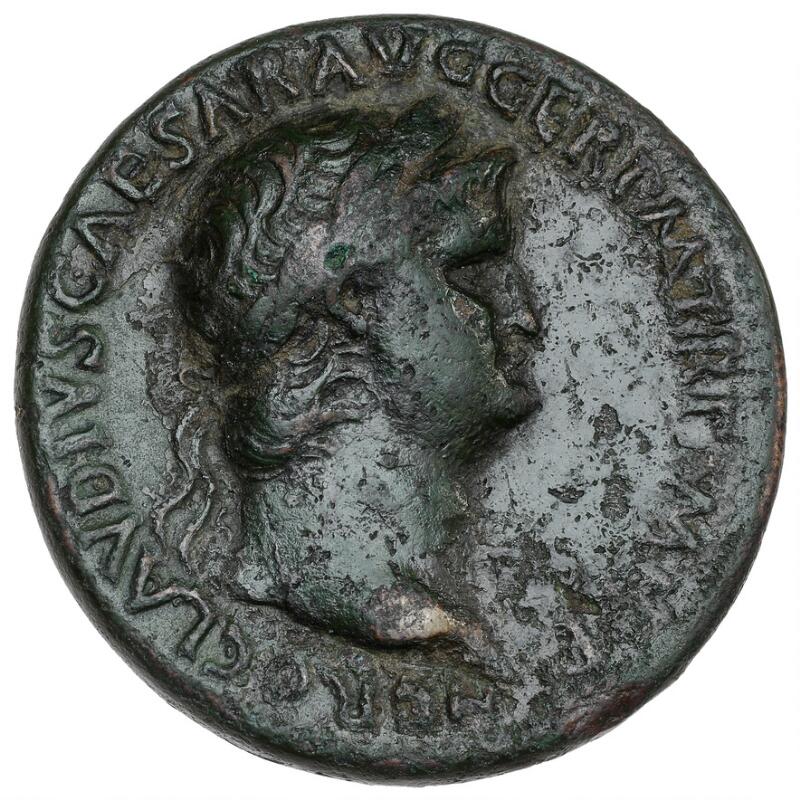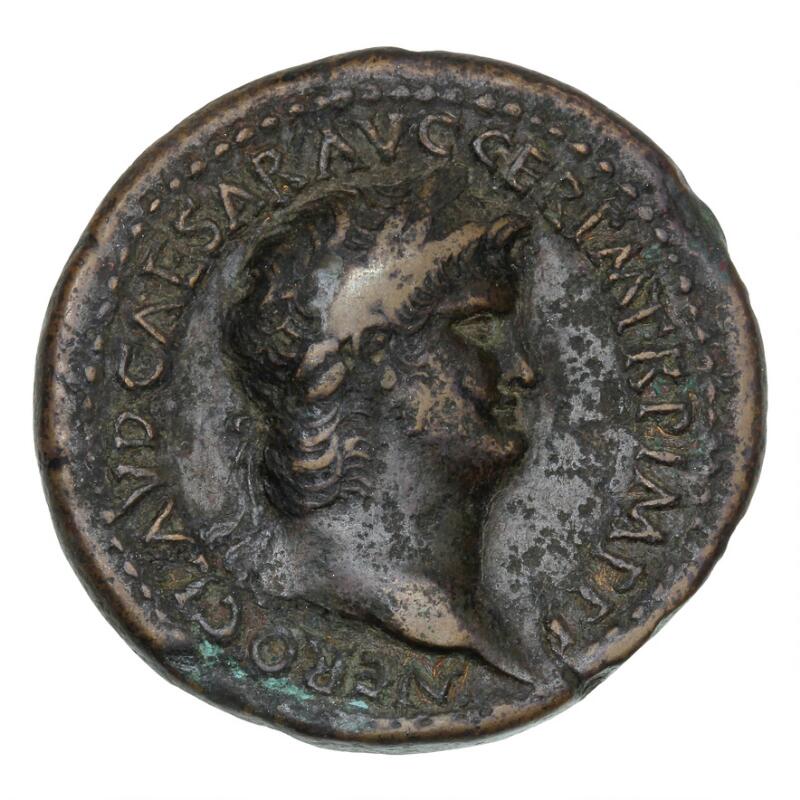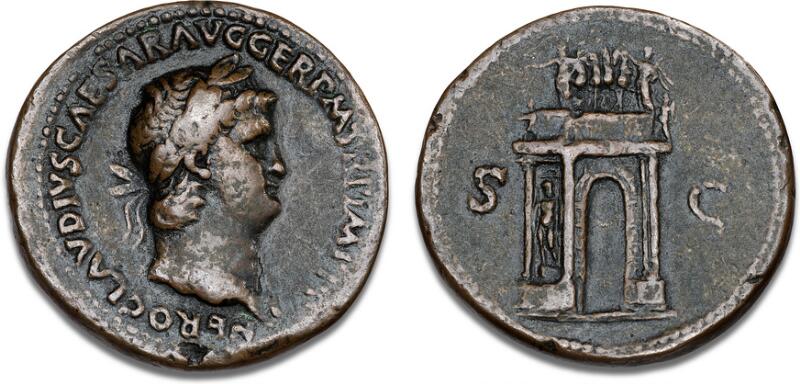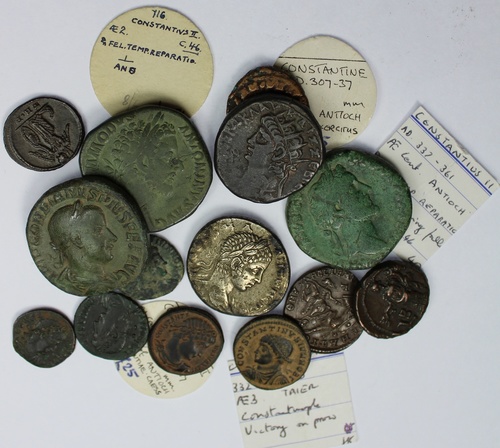Nero Æ Sestertius. Rome, AD 65. NERO CLAVD CAESAR AVG GER P M TR P IMP P P, laureate bust right, wearing aegis on left shoulder / PACE P R TERRA [MARI]Q PARTA IANVM CLVSIT, view of the Temple of Janus, decorated with garlands and with door closed; S-C across fields. RIC 266; C. 162; BN 365; BMCRE 161. 29.17g, 37mm, 6h. Extremely Fine; A finely detailed portrait of beautiful style, with an equally well detailed depiction of the Temple of Janus. Janus was a god unique to the Romans, for whom the ancient Greek pantheon (whence the greater part of the Roman religion was derived) had no equivalent. Janus was the god of gateways, beginnings and endings, transitions and duality, of war and peace. The structure commonly referred to as the Temple of Janus, but more correctly the Ianus Geminus, Ianus Quirinus or Portae Belli, was not a temple at all in the traditional sense. Built by the second king of Rome, Numa Pompilius, the doors of the Ianus Geminus were opened to indicate that Rome was at war and closed during times of peace. Since the time of Numa and before the time of Nero, the doors were said to have been closed only in 235 BC, after the first Punic war; and three times during the reign of Augustus. The structure itself was probably originally conceived and executed in wood and other perishable materials, but contained an archaic bronze statue of the god which held in the one hand a key, denoting his role as the supreme gate-keeper in both spatial and temporal senses, and in the other a staff, signifying both his authority and role as a divine guide. Said to have been situated between the Forum Julium and the Forum Romanum, close to where the Argiletum entered the forum, it consisted of twin gates opposite each other; the cult statue was between them. No roof is indicated, and it may have been an open enclosure. While there is no literary evidence that the temple was destroyed or rebuilt, it must have been moved to make way for the construction of the Basilica Aemilia in 179 BC. The Ianus Geminus as it existed from that time until the reign of Domitian, and as depicted on this and other coins struck by Nero, evidently had walls of ashlar masonry under a grated window set beneath a decorated frieze. Double doors of bronze and iron are reported by Virgil, and are shown framed by columns, with a wreath hanging overhead. Virgil, whose literary epic the Aeneid enshrined and embellished Roman traditions for eternal posterity, relates that “When the senators have irrevocably decided for battle, the consul himself, a figure conspicuous in Quirine toga of State and Gabine cincture, unbolts these gates, and their hinge-posts groan; it is he who calls the fighting forth” (Virgil, Aeneid, VII.601-615). Yet Virgil and his contemporaries Ovid and Horace disagreed on the meaning of the ritual closing of the gates. To Virgil, it was War that was being locked behind the twin gates; for Ovid and Horace, it was Peace that was kept within. Regardless, the symbolism of opening or closing the gates of the Ianus Geminus was powerful indeed; thus following the favourable end to a war with Parthia in 63 thanks to the efforts of the general Gnaeus Domitius Corbulo, and the general establishment of peace across Rome’s borders by 65, Nero famously closed the doors to great fanfare in AD 66 as a sign that all war was at an end.
Nero Æ Sestertius. Rome, AD 65. NERO CLAVD CAESAR AVG GER P M TR P IMP P P, laureate bust right, wearing aegis on left shoulder / PACE P R TERRA [MARI]Q PARTA IANVM CLVSIT, view of the Temple of Janus, decorated with garlands and with door closed; S-C across fields. RIC 266; C. 162; BN 365; BMCRE 161. 29.17g, 37mm, 6h. Extremely Fine; A finely detailed portrait of beautiful style, with an equally well detailed depiction of the Temple of Janus. Janus was a god unique to the Romans, for whom the ancient Greek pantheon (whence the greater part of the Roman religion was derived) had no equivalent. Janus was the god of gateways, beginnings and endings, transitions and duality, of war and peace. The structure commonly referred to as the Temple of Janus, but more correctly the Ianus Geminus, Ianus Quirinus or Portae Belli, was not a temple at all in the traditional sense. Built by the second king of Rome, Numa Pompilius, the doors of the Ianus Geminus were opened to indicate that Rome was at war and closed during times of peace. Since the time of Numa and before the time of Nero, the doors were said to have been closed only in 235 BC, after the first Punic war; and three times during the reign of Augustus. The structure itself was probably originally conceived and executed in wood and other perishable materials, but contained an archaic bronze statue of the god which held in the one hand a key, denoting his role as the supreme gate-keeper in both spatial and temporal senses, and in the other a staff, signifying both his authority and role as a divine guide. Said to have been situated between the Forum Julium and the Forum Romanum, close to where the Argiletum entered the forum, it consisted of twin gates opposite each other; the cult statue was between them. No roof is indicated, and it may have been an open enclosure. While there is no literary evidence that the temple was destroyed or rebuilt, it must have been moved to make way for the construction of the Basilica Aemilia in 179 BC. The Ianus Geminus as it existed from that time until the reign of Domitian, and as depicted on this and other coins struck by Nero, evidently had walls of ashlar masonry under a grated window set beneath a decorated frieze. Double doors of bronze and iron are reported by Virgil, and are shown framed by columns, with a wreath hanging overhead. Virgil, whose literary epic the Aeneid enshrined and embellished Roman traditions for eternal posterity, relates that “When the senators have irrevocably decided for battle, the consul himself, a figure conspicuous in Quirine toga of State and Gabine cincture, unbolts these gates, and their hinge-posts groan; it is he who calls the fighting forth” (Virgil, Aeneid, VII.601-615). Yet Virgil and his contemporaries Ovid and Horace disagreed on the meaning of the ritual closing of the gates. To Virgil, it was War that was being locked behind the twin gates; for Ovid and Horace, it was Peace that was kept within. Regardless, the symbolism of opening or closing the gates of the Ianus Geminus was powerful indeed; thus following the favourable end to a war with Parthia in 63 thanks to the efforts of the general Gnaeus Domitius Corbulo, and the general establishment of peace across Rome’s borders by 65, Nero famously closed the doors to great fanfare in AD 66 as a sign that all war was at an end.







/196782/Photo1%20data.jpg)
/189699/Photo1%20data.jpg)




/195082/Photo1%20data.jpg)

Try LotSearch and its premium features for 7 days - without any costs!
Be notified automatically about new items in upcoming auctions.
Create an alert